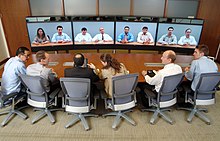The Telecommunication Portal

Telecommunication, often used in its plural form, is the transmission of information with an immediacy comparable to face-to-face communication. As such, slow communications technologies like postal mail and pneumatic tubes are excluded from the definition. Many transmission media have been used for telecommunications throughout history, from smoke signals, beacons, semaphore telegraphs, signal flags, and optical heliographs to wires and empty space made to carry electromagnetic signals. These paths of transmission may be divided into communication channels for multiplexing, allowing for a single medium to transmit several concurrent communication sessions. Several methods of long-distance communication before the modern era used sounds like coded drumbeats, the blowing of horns, and whistles. Long-distance technologies invented during the 20th and 21st centuries generally use electric power, and include the telegraph, telephone, television, and radio.
Early telecommunication networks used metal wires as the medium for transmitting signals. These networks were used for telegraphy and telephony for many decades. In the first decade of the 20th century, a revolution in wireless communication began with breakthroughs including those made in radio communications by Guglielmo Marconi, who won the 1909 Nobel Prize in Physics. Other early pioneers in electrical and electronic telecommunications include co-inventors of the telegraph Charles Wheatstone and Samuel Morse, numerous inventors and developers of the telephone including Antonio Meucci and Alexander Graham Bell, inventors of radio Edwin Armstrong and Lee de Forest, as well as inventors of television like Vladimir K. Zworykin, John Logie Baird and Philo Farnsworth.
Since the 1960s, the proliferation of digital technologies has meant that voice communications have gradually been supplemented by data. The physical limitations of metallic media prompted the development of optical fibre. The Internet, a technology independent of any given medium, has provided global access to services for individual users and further reduced location and time limitations on communications. (Full article...)
Selected article -

Videotelephony (also known as videoconferencing, video teleconferencing, or simply video call) is the two-way or multipoint reception and transmission of audio and video signals by people in different locations for real-time communication. A videophone is a telephone with a video camera and video display, capable of simultaneous video and audio communication. Videoconferencing implies the use of this technology for a group or organizational meeting rather than for individuals, in a videoconference. Telepresence may refer either to a high-quality videotelephony system (where the goal is to create the illusion that remote participants are in the same room) or to meetup technology, which can go beyond video into robotics (such as moving around the room or physically manipulating objects). Videoconferencing has also been called visual collaboration and is a type of groupware.
While development of video-conferring started in the late 19th century, the technology only became available to the public starting in the 1930s. These early demonstrations were installed at booths in post offices and shown at various world expositions. It took until 1970 for AT&T to launch the first true video-conferring system, where anyone could subscribe to the service and have the technology in their home or office. Videotelephony also included image phones which would exchange still images between units every few seconds over conventional plain old telephone service (POTS) lines, essentially the same as slow-scan TV. The development of advanced video codecs, more powerful CPUs, and high-bandwidth Internet service in the late 1990s allowed videophones to provide high-quality low-cost color service between users almost any place in the world where the Internet is available. (Full article...)General images
Things to do
 |
Here are some tasks awaiting attention:
|
Selected biography -
Philo Taylor Farnsworth (August 19, 1906 – March 11, 1971) was an American inventor and television pioneer. He made the critical contributions to electronic television that made possible all the video in the world today. He is best known for his 1927 invention of the first fully functional all-electronic image pickup device (video camera tube), the image dissector, as well as the first fully functional and complete all-electronic television system. Farnsworth developed a television system complete with receiver and camera—which he produced commercially through the Farnsworth Television and Radio Corporation from 1938 to 1951, in Fort Wayne, Indiana.
In later life, Farnsworth invented a small nuclear fusion device, the Farnsworth Fusor, employing inertial electrostatic confinement (IEC). Like many fusion devices, it was not a practical device for generating nuclear power, although it provides a viable source of neutrons. The design of this device has been the inspiration for other fusion approaches, including the Polywell reactor concept. Farnsworth held 300 patents, mostly in radio and television. (Full article...)Did you know (auto-generated) -

- ... that Angeline Quinto became the first Filipino singer to release a soundtrack album for a television series that featured a single artist?
- ... that Milton Grant went from disc jockey and bandstand host to an owner of television stations?
- ... that former International Brigades doctor Walter Fischer managed the Austrian broadcasts of Radio Moscow during World War II?
- ... that the owners of North Carolina radio station WBIG justified shutting it down by noting that the metropolitan area had outgrown its signal?
- ... that ethnic broadcasting pioneer Shushma Datt was the first Canadian woman to obtain a CRTC broadcast licence?
- ... that Sunday-school classes were once held in the transmitter building of New Mexico radio station KCLV?
Related portals
Topics
Subcategories
Associated Wikimedia
The following Wikimedia Foundation sister projects provide more on this subject:
-
 Commons
Commons
Free media repository -
 Wikibooks
Wikibooks
Free textbooks and manuals -
 Wikidata
Wikidata
Free knowledge base -
 Wikinews
Wikinews
Free-content news -
 Wikiquote
Wikiquote
Collection of quotations -
 Wikisource
Wikisource
Free-content library -
 Wikiversity
Wikiversity
Free learning tools -
 Wiktionary
Wiktionary
Dictionary and thesaurus
-

-

-

-

-
Random portal
Purge server cache

















































































